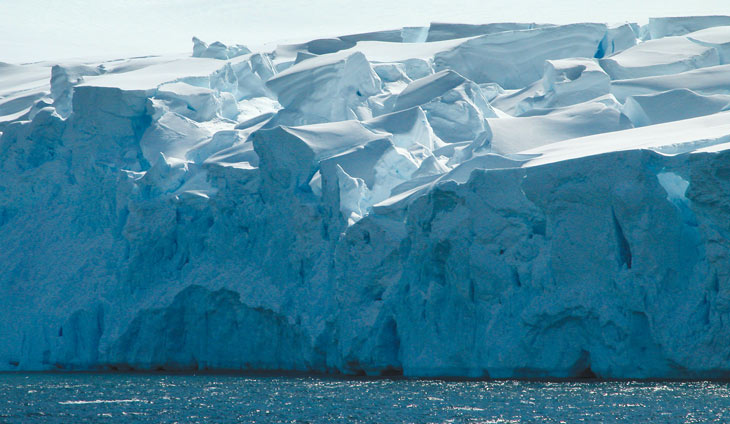
STEEP SHELF Relatively warm deep waters are eating away at Antarctica’s ice shelves, such as the Stange ice shelf in West Antarctica (shown).
Mark Brandon
- More than 2 years ago
Sea level rise over the next century won’t get a feared boost from Antarctic ice cliffs crumbling into the ocean like dominoes, a new study suggests.
The finding, published February 7 in Nature, is based on a new statistical analysis showing that such a rapid collapse of marine ice cliffs in Antarctica was extremely unlikely to have happened in the past, even during some of Earth’s warmest episodes over the last 3 million years.
The study, by climate scientist Tamsin Edwards of King’s College London and colleagues, counters a controversial hypothesis that suggests that rising greenhouse gas emissions could destabilize those cliffs and help send sea levels surging by over 2.1 meters by 2100. That figure is nearly double some sea level rise projections for the end of the century.
How quickly human-caused global warming is causing the great ice sheets covering Greenland and Antarctica to melt into the sea is one of the most urgent questions related to future sea level rise.
Some scientists fear that melting could speed up dramatically sometime in the future, thanks to a possible feedback loop known as marine ice-cliff instability, or MICI. The hypothesis was described by geoscientist Robert DeConto of the University of Massachusetts Amherst and paleoclimatologist David Pollard of Penn State in a 2016 study in Nature. Using computer simulations of the mechanical and structural properties of ice, the researchers suggested that ice cliffs at the edges of glaciers that jut into the sea are a dramatically underestimated source of future sea level rise (SN: 4/30/16, p. 13).
“Ice that flows into the ocean essentially always ends in a cliff,” DeConto says. “Basic physics tells us that very tall cliffs, extending 100 meters or more above the water surface, will begin to produce stresses in the ice that can exceed its strength.” When that happens, the ice breaks, or calves, and giant blocks of ice tumble into the sea. The collapse of such cliffs would then create new cliffs behind them that would tumble as well, in a kind of domino effect.

One reason the MICI hypothesis was controversial is that there are a lot of uncertainties about the progression and effects of such cliff collapse, Edward says. Would all the blocks end up in the sea? How much surface melting of the ice would there be, and how would that meltwater help speed the fractures along? “We would all agree that ice cliffs might have a maximum height and above that they’re unstable, that the strength of ice has a limit,” she says. But the question is how that translates to sea level rise.
To figure out whether a MICI feedback might have actually happened in Earth’s past, Edwards and her colleagues ran a statistical analysis of the original MICI simulation. They wanted to determine the likelihood that sea level rise during warm episodes might have been linked to ice-cliff collapse in Antarctica. The researchers focused on the mid-Pliocene warm period that lasted from about 3.3 million to 3 million years ago, the last interglacial period 130,000 to 115,000 years ago, and the years from 1992 to 2017, which span the time for which satellite data of the rate of ice mass loss exist.
The original computer simulations of ice-cliff collapse by DeConto and Pollard included only about 64 iterations. “We were limited by cost in how many simulations we can run,” says DeConto. Edwards’ team, however, mapped out statistically how the simulation would respond in 10,000 different iterations, by changing parameters from the estimated rate of atmospheric warming to estimated past sea level rise. The MICI hypothesis, the researchers found, wasn’t needed to reproduce any of the past sea level changes during those three time periods.
DeConto says he’s happy that researchers are trying to test the ice-cliff instability theory. “I think we’ve shaken some trees,” he says. “The fact that folks are pushing back is a good thing.” And Edwards’ team’s study, he adds, highlighted the usefulness of statistically analyzing many possible outcomes for a computer simulation.
Meanwhile, he, Pollard and other colleagues presented an updated computer simulation of how MICI might affect future sea level rise in December in Washington, D.C., at the American Geophysical Union annual meeting. Their newest findings support the Edwards’ team’s conclusion that marine ice-cliff instability won’t double sea levels by 2100 — but suggest that’s only because the ice-cliff instability hasn’t really kicked in yet. By 2200, they say, the picture is far less rosy: If greenhouse gas emissions continue on their current track, MICI could help bump up sea level up to as much as 4 meters higher than they were in 2000.







